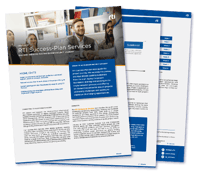3 min read
The Fastest Path Forward: Building Golden Dome on Proven Foundations
 John Breitenbach
:
November 18, 2025
John Breitenbach
:
November 18, 2025

The Mission and the Clock
Golden Dome has a clear objective: create an integrated homeland-defense architecture capable of detecting and defeating everything from small drones to hypersonic threats.
The harder part is the schedule. The program’s timeline is measured in years, not decades. This alone goes against anything the Pentagon has historically been able to field at scale.
In large defense programs, speed is rarely a function of effort. It’s a function of reuse. Every subsystem, data model, or certification that can be carried forward instead of recreated shortens the path to fielding.
Reusing What Already Works
Most of the hardware and command-and-control elements that will feed Golden Dome already exist – Aegis, IBCS, THAAD, SPY-6, Counter-UxS systems, and others.
What’s missing isn’t capability; it’s cross-system coordination.
The fastest route to that cohesion is to build on the software and communication frameworks already connecting these systems today. Many of those frameworks – including those based on the open Data Distribution Service (DDS™) standard – are operational and proven.
Because these communication frameworks are already deployed across these platforms, primes can integrate new capabilities rather than reinvent the transport layer.
Speed Through Modularity
Every time an interface is rebuilt or recertified, weeks, months, even years are lost.
Programs that separate what changes (mission logic) from what endures (data transport, timing, and governance) can evolve continuously without re-starting the development clock.
This is the essence of modularity – isolating innovation from infrastructure. It allows new AI modules, effectors, or sensors to plug into the same certified backbone without rewriting the entire system.
Reducing Schedule Risk Through Connection, Not Commonality
Traditional integration models depend on consensus – endless meetings to define “common” data models and shared ontologies. But consensus takes time, and time is the one thing Golden Dome doesn’t have.
A smarter path is to connect systems as they are. With the right routing architecture, programs don’t need to wait for everyone to agree on a single data model. They can simply translate and synchronize existing ones in real time.
This approach turns diversity into speed. Legacy systems keep their native formats. New systems plug in instantly. And together, they operate as one network – without the decade-long detour of standardization.
It’s not about forcing commonality; it’s about enabling coherence. That’s the quiet advantage of modern routing frameworks: they let integration happen at machine speed, not committee speed.
Designing for Evolution, Not Completion
Golden Dome won’t have a final, finished state – and that’s the point. Threats will shift faster than any standards body or working group can keep up with. The job isn’t to chase perfect agreement up front, but to build an architecture that can move as fast as the threat environment.
That means focusing on an approach that lets new sensors, new analytics, and new coalition partners plug in without derailing timelines. This is not about waiting for the perfect model or universal consensus – it’s about creating enough shared structure to move now, and enough flexibility to adapt later.
In a world where the DoD is pushing for 85% solutions that can be fielded quickly, the advantage goes to programs that can evolve continuously rather than restart every time something changes. The systems that win will be the ones designed to grow.
The Life Cycle Imperative
Sustainment and upgrade planning must begin at design. Building on existing frameworks means inheriting not only tested software, but also established training, documentation, and accreditation paths.
The result is a smoother life cycle – from rapid prototyping to operational deployment to in-theater upgrade – where modernization becomes incremental and continuous instead of episodic. For a system expected to endure for decades, that difference determines long-term affordability.
A Realistic Blueprint for Schedule Success
To meet a projected 2027 horizon, Golden Dome’s architects should anchor on four imperatives:
- Reuse proven software infrastructure. Build on the frameworks already in fielded systems.
- Engineer for modularity. Keep upgrades isolated from certified baselines.
- Institutionalize interoperability. Establish shared data standards that every system follows, instead of each contractor defining their own.
- Treat integration as continuous. Frequent testing is the best insurance against late surprises.
These aren’t aspirational ideas – they’re lessons learned from existing missile-defense and command-and-control programs that have already proven their worth.
If Golden Dome follows that blueprint, the U.S. can meet its aggressive timeline without sacrificing resilience or reliability.
For more on RTI in A&D, please read this recent Press Release: RTI Connext Recognized as the Gold Standard for Accelerating Defense System Deployment
About the author:

John Breitenbach, Director Aerospace & Defense Markets, RTI
John Breitenbach is Director of Aerospace & Defense Markets for Real-Time Innovations. He has over 30 years of experience designing software for intelligent machines. He’s worked on industrial, medical, consumer and military products – everything from artificial hearts to autonomous vehicles to elevators.
Posts by Tag
- Developers/Engineer (180)
- Technology (79)
- Connext Suite (77)
- News & Events (75)
- 2020 (54)
- Standards & Consortia (51)
- Aerospace & Defense (50)
- Automotive (37)
- 2023 (34)
- 2022 (29)
- IIoT (27)
- Leadership (24)
- 2024 (22)
- Healthcare (22)
- 2025 (21)
- Connectivity Technology (21)
- Cybersecurity (20)
- 2021 (18)
- Culture & Careers (15)
- Military Avionics (15)
- FACE (13)
- Connext Pro (10)
- JADC2 (10)
- ROS 2 (10)
- Connext Tools (7)
- Connext Micro (6)
- Databus (6)
- Transportation (5)
- Case + Code (4)
- Connext (4)
- Connext Cert (4)
- Energy Systems (4)
- FACE Technical Standard (4)
- Oil & Gas (3)
- Research (3)
- Robotics (3)
- #A&D (2)
- AI (2)
- Connext Conference (2)
- Edge Computing (2)
- MDO (2)
- MS&T (2)
- RTI Labs (2)
- TSN (2)
- ABMS (1)
- C4ISR (1)
- DOD (1)
- Golden Dome (1)
- ISO 26262 (1)
- L3Harris (1)
- LabView (1)
- MOSA (1)
- MathWorks (1)
- National Instruments (1)
- Simulation (1)
- Tech Talks (1)
- UAM (1)
- Videos (1)
- eVTOL (1)
 Success-Plan Services
Success-Plan Services